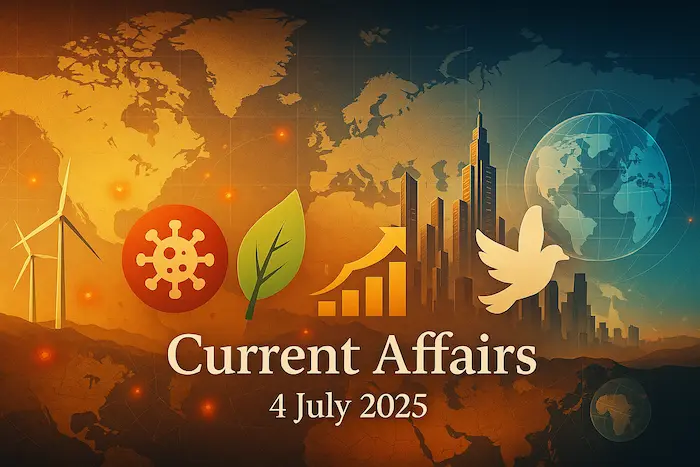1. PM Modi’s Five-Nation Visit: India’s Outreach to the Global South – International Relations
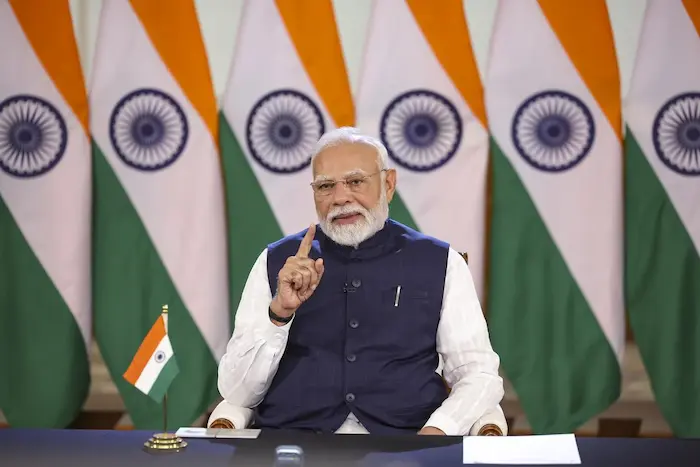
Why in News?
Prime Minister Narendra Modi is undertaking a significant five-nation visit from July 2 to July 9, 2025, covering Ghana, Trinidad & Tobago, Argentina, Brazil, and Namibia. The tour is aimed at deepening India’s engagement with the Global South—a term referring to developing countries in Africa, Latin America, Asia, and Oceania.
Objective of the Visit
- Strengthen South-South cooperation
- Promote economic and strategic partnerships
- Enhance diaspora diplomacy
- Expand cooperation in critical minerals, climate change, digital public infrastructure, and vaccine diplomacy
Country-wise Highlights & Strategic Significance
Ghana
- First Indian PM visit in 30 years
- India is Ghana’s largest export market (mainly gold)
- Proposed setting up a vaccine manufacturing hub—building on India’s goodwill during COVID-19.
- Promotes health diplomacy and technology transfer
Strategic Relevance:
- Expands India’s presence in West Africa
- Counters Chinese influence in the region
Trinidad & Tobago
- First bilateral visit by an Indian PM in over 20 years
- Strong Indian diaspora presence (40–45% of population)
- Commemorated 180th anniversary of Indian immigration
Strategic Relevance:
- Deepens people-to-people ties
- Enhances cultural diplomacy and diaspora engagement
Argentina
- First bilateral visit in 57 years
- Focus on:
- Lithium (critical for EV batteries)
- Agricultural cooperation
- Political uncertainty under President Javier Milei poses challenges
Strategic Relevance:
- Strengthens India’s energy security (critical minerals)
- Argentina is a member of India-MERCOSUR trade bloc
Brazil
- Visit follows the BRICS Leaders’ Summit
- Focus on strengthening the India-Brazil Strategic Partnership
- Brazil is India’s largest trading partner in South America
- Both countries face growing Chinese influence
Strategic Relevance:
- Strengthens multilateral cooperation (especially via BRICS and G20)
- Advances India’s South American footprint
Namibia
- First Indian PM visit
- Discussions on:
- Biodiversity and environmental cooperation
- Digital Public Infrastructure
- Recalls the translocation of African cheetahs to India (Project Cheetah)
Strategic Relevance:
- Enhances India-Africa conservation diplomacy
- Taps into emerging digital markets in Africa
Key Themes Across the Tour
| Theme | Relevance |
|---|---|
| South-South Cooperation | Reinforces India’s role as a leader of the Global South |
| Mineral Security | Access to lithium, gold, rare earths |
| Health & Vaccine Diplomacy | Vaccine hub proposal in Ghana |
| Diaspora Diplomacy | Emotional connect with Trinidad & Tobago |
| Environmental Diplomacy | Cheetah project and climate action |
| Digital Infrastructure | Knowledge sharing with developing nations |
Exam Connect – Possible Questions
Prelims
- Which of the following countries did PM Modi visit during his five-nation tour in July 2025?
A. Ghana, Brazil, Peru, Argentina, Namibia
B. Ghana, Trinidad & Tobago, Argentina, Brazil, Namibia
C. Nigeria, Trinidad & Tobago, Argentina, Brazil, Kenya
D. Ghana, Jamaica, Argentina, Chile, Namibia
Answer: B. Ghana, Trinidad & Tobago, Argentina, Brazil, Namibia - India is the largest export market for which of the following countries visited by PM Modi in 2025?
A. Brazil
B. Argentina
C. Ghana
D. Namibia
Answer: C. Ghana - The translocation of cheetahs from Namibia to India is part of which project?
A. Project Panthera
B. Project Cheetah
C. Project Conservation
D. Project Jungle Cat
Answer: B. Project Cheetah
Mains
- Discuss the significance of Prime Minister Modi’s five-nation tour in strengthening India’s relations with the Global South. How does this align with India’s broader foreign policy objectives?
- India’s outreach to Africa and Latin America reflects a shift in its global diplomatic approach. Critically evaluate the strategic relevance of such regions in India’s foreign policy in the 21st century.
- How can partnerships in critical minerals and digital infrastructure with Latin American and African countries contribute to India’s economic and technological goals?
2. Gig Workers in India: Data Gaps and the Need for Inclusive Labour Statistics – Economy
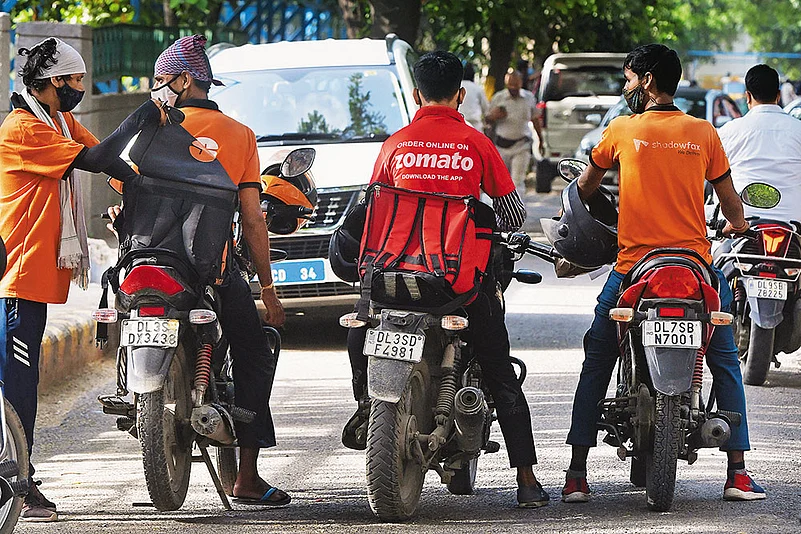
Why in News?
India’s primary labour force survey — the Periodic Labour Force Survey (PLFS) — is under scrutiny for failing to adequately account for the growing gig and platform workforce, even as gig work becomes a defining feature of India’s modern economy. This data shortfall undermines the effectiveness of welfare policies targeting gig workers.
Key Takeaways
- The gig workforce is projected to reach 23.5 million by 2029–30 (NITI Aayog, 2022).
- The 2025 Union Budget extended key social protection measures to gig and platform workers.
- PLFS continues to misclassify gig workers as self-employed or casual labourers, masking key vulnerabilities such as income instability and lack of formal contracts.
Understanding Gig and Platform Work
Who are Gig Workers?
Gig workers are individuals engaged in temporary, flexible, and on-demand jobs, often mediated by digital platforms.
Examples:
- Food delivery agents (e.g., Zomato, Swiggy)
- Ride-hailing drivers (e.g., Uber, Ola)
- Online freelancers (e.g., writing, coding, graphic design)
- Home service providers (e.g., Urban Company)
Legal Definition:
Under the Code on Social Security, 2020, a gig worker is defined as:
“A person who performs work outside of traditional employer-employee relationships.”
However, the law lacks clear demarcation between gig workers, casual labour, and self-employed individuals.
Problem with Current Labour Data
Limitations of the PLFS (Periodic Labour Force Survey):
- No specific category for gig workers.
- Gig workers are lumped under ‘self-employed’ or ‘casual workers’.
- Ignores gig-specific issues like:
- Multiple job holdings
- No employment benefits
- High income fluctuation
- Digital mediation of work
Result: Inadequate data leads to policy misalignment and exclusion from targeted welfare schemes.
Current Government Initiatives
| Initiative | Objective |
|---|---|
| e-Shram Portal | Registration of unorganised and gig workers for welfare access |
| Digital ID for Gig Workers | Improve traceability and inclusion in government schemes |
| 2025 Budget Measures | Extend health and accident insurance to gig workers |
Challenge: Without accurate data, the coverage, design, and impact of such schemes cannot be assessed effectively.
The Way Forward: Towards Inclusive Labour Statistics
Recommendations:
- Update PLFS design to include a separate classification for gig/platform workers.
- Introduce dedicated survey modules to capture:
- Work duration and frequency
- Income variability
- Platform dependency
- Access to social protection
- Leverage data from:
- e-Shram database
- Platform companies (public-private data collaboration)
Why it matters: India’s labour policy must reflect the changing nature of work, especially in urban digital economies, to ensure welfare equity and inclusive growth.
Exam Connect – Possible Questions
Prelims
1. Which of the following best defines a ‘gig worker’ in the Indian context?
A. A government-employed contract worker
B. An employee working full-time in a factory
C. A worker performing income-generating work outside the traditional employer-employee framework
D. A worker associated only with agricultural activities
Answer: C. A worker performing income-generating work outside the traditional employer-employee framework
2. Which Indian labour law defines gig and platform workers?
A. Industrial Disputes Act, 1947
B. Code on Social Security, 2020
C. Minimum Wages Act, 1948
D. Factories Act, 1948
Answer: B. Code on Social Security, 2020
3.What is the main limitation of the PLFS with respect to gig workers?
A. It excludes rural labourers
B. It does not collect income data
C. It classifies gig workers under broader categories like self-employed
D. It overestimates gig employment
Answer: C. It classifies gig workers under broader categories like self-employed
Mains
- With reference to the growth of gig and platform-based employment in India, critically examine the limitations of existing labour statistics and suggest ways to ensure inclusive welfare coverage.
- Do you think initiatives like e-Shram and digital ID schemes are sufficient to ensure social security for gig workers? Discuss with suitable examples.
- In the context of the gig economy, analyse the need for a new regulatory and statistical framework to address labour vulnerabilities in India.
3. Dalai Lama and His Reincarnation: A Cultural and Political Legacy – History & Culture
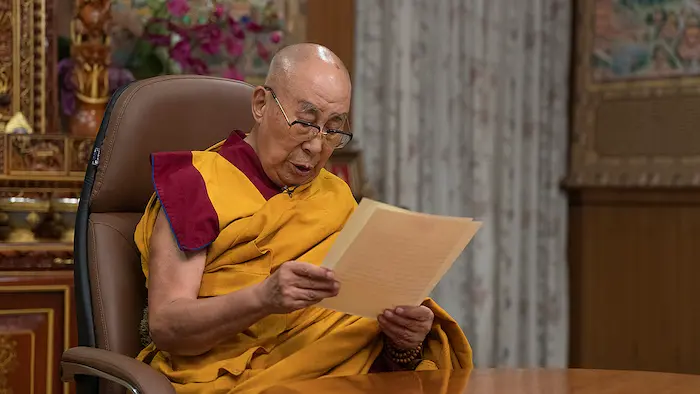
Why in News?
As the 14th Dalai Lama approaches his 90th birthday on July 6, 2025, he has reiterated that the institution of the Dalai Lama will continue through reincarnation. This counters China’s claim that it holds the authority to determine the next Dalai Lama, intensifying the geopolitical and cultural debate around Tibetan identity and religious autonomy.
Who is the Dalai Lama?
- The Dalai Lama is the spiritual head of the Gelug school, the most influential school of Tibetan Buddhism.
- The term “Dalai Lama” means “Ocean of Wisdom”.
- The title was first conferred in the 16th century by Altan Khan, a Mongol ruler, to Sonam Gyatso, who became the 3rd Dalai Lama (the first two were posthumously recognized).
Tenzin Gyatso: The 14th Dalai Lama
| Aspect | Details |
|---|---|
| Birth | 1935, in Taktser, northeastern Tibet |
| Recognition | Identified in 1939 as the reincarnation of the 13th Dalai Lama |
| Enthronement | Officially enthroned in 1940 |
| Exile | Fled to India in 1959 after the Chinese annexation of Tibet |
| Base in India | Established the Tibetan Government-in-Exile in Dharamsala, Himachal Pradesh |
| Political Transition | Transferred political leadership to the elected Tibetan Parliament-in-Exile in 2011 |
| Global Recognition | Awarded the Nobel Peace Prize in 1989 for non-violent advocacy |
Reincarnation and the Tulku System
- Tulku: A reincarnated lama or teacher in Tibetan Buddhism.
- The Dalai Lama is believed to be a reincarnation of Avalokiteshvara, the Bodhisattva of Compassion.
- The Panchen Lama, Karmapa, and others are also part of this reincarnate lineage system.
Process of Reincarnation Identification:
- After the death of a Dalai Lama, senior monks search for a child who shows signs of being the reincarnation.
- The search can take years and is guided by spiritual signs, visions, and rituals.
Controversy: China claims it has the right to approve reincarnations, asserting state control over religious institutions. This has led to competing versions of the Panchen Lama and could impact the future of the Dalai Lama lineage.
Tibetan Buddhism: Key Features
| Theme | Description |
|---|---|
| Philosophical Base | Combines Mahayana Buddhism, Tantric Vajrayana rituals, and Bon indigenous practices |
| Major Schools | 1. Nyingma (oldest) 2. Kagyu 3. Sakya 4. Gelug (Dalai Lama’s school) |
| Founding of Gelug | Founded in the 14th century by Je Tsongkhapa, a reformist scholar |
| Important Texts | – Kangyur (Words of the Buddha) – Tengyur (Commentaries) |
| Meditation Practices | – Dzogchen (Great Perfection) – Mahamudra (Great Seal) |
| Monasteries | – Drepung, Ganden, Sera, Tashi Lhunpo |
Tibetan Buddhism in the World Today
- Flourishing in Himalayan regions: Ladakh, Himachal Pradesh, Sikkim, Arunachal Pradesh, Bhutan, Nepal
- Dharamsala (Himachal Pradesh) is the headquarters of the Tibetan Government-in-Exile
- Gaining influence in Western countries, especially among spiritual seekers and academics
- Dalai Lama is a global figure promoting interfaith dialogue, peace, and secular ethics
Exam Connect – Possible Questions
Prelims
- The term “Dalai Lama” was first used by which of the following rulers?
A. Kublai Khan
B. Altan Khan
C. Genghis Khan
D. Sonam Gyatso
Answer: B. Altan Khan - Which of the following texts are part of the Tibetan Buddhist canon?
A. Tripitaka and Jataka
B. Mahabharata and Puranas
C. Kangyur and Tengyur
D. Avesta and Zend
Answer: C. Kangyur and Tengyur - The Gelug school of Tibetan Buddhism was founded by:
A. Padmasambhava
B. Milarepa
C. Je Tsongkhapa
D. Atisha
Answer: C. Je Tsongkhapa - Which monastery is traditionally associated with the Panchen Lama?
A. Ganden
B. Sera
C. Tashi Lhunpo
D. Jokhang
Answer: C. Tashi Lhunpo
Mains
- Discuss the significance of the Tulku system in Tibetan Buddhism. How does the institution of the Dalai Lama embody both religious and political aspects of Tibetan identity
- Tibetan Buddhism is not only a religious tradition but also a means of cultural resistance. Examine the role of the Dalai Lama and Tibetan monasteries in preserving this heritage, especially in exile.
- India’s support for the Dalai Lama reflects a complex intersection of spiritual sanctuary, cultural diplomacy, and geopolitical strategy. Critically evaluate this dimension in Indo-China relations.
4. Why Tigers Keep Migrating? – Environment
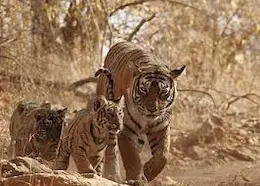
Why in News?
India is witnessing an eastward migration of tigers, particularly young male tigers dispersing from Central Indian reserves like Kanha, Tadoba, and Bandhavgarh toward eastern states such as Jharkhand, Odisha, and West Bengal. This growing trend has ecological significance and raises concerns over human-wildlife conflict and habitat readiness in recipient areas.
Key Migration Routes & Recent Incidents
| Origin | Destination | Outcome |
|---|---|---|
| Bandhavgarh (Madhya Pradesh) | Palamu (Jharkhand) → Purulia (West Bengal) | Tiger rescued and sent back to Palamu |
| Simlipal (Odisha) | Jharkhand → Lalgarh (West Bengal) | Tiger killed by villagers |
| Tadoba (Maharashtra) | Simlipal → West Bengal | Zeenat, a tigress, translocated |
Back2Basics: Royal Bengal Tiger (Panthera tigris tigris)
- Status: National Animal of India (declared in 1972 by IBWL)
- Habitat Range:
- India (75% of world population)
- Also found in Bangladesh, Nepal, Bhutan, China, Myanmar
- Preferred Habitats:
- Tropical deciduous forests
- Mangrove swamps (e.g., Sundarbans)
- Shola forests, grasslands, and high-altitude areas
Ecological Significance
| Term | Explanation |
|---|---|
| Flagship species | Their presence represents healthy ecosystems; drives public conservation efforts |
| Umbrella species | Conservation of tigers also protects several other species in the same habitat |
Protection Status
| Framework | Status |
|---|---|
| Indian Wildlife Protection Act, 1972 | Schedule I (highest protection) |
| IUCN Red List | Endangered |
| CITES | Appendix I (no commercial trade) |
| Project Tiger (1973) | Government-led conservation initiative |
Why Do Tigers Migrate? — Behavioural and Ecological Drivers
1. Territorial Independence
- Male tigers leave their birth territories on maturity to find their own hunting grounds and mates.
- Triggered by competition and resource pressure in core reserves.
2. Gendered Dispersal Patterns
- Males: Wide-ranging, often crossing multiple state borders
- Females: Tend to stay near their birthplace (philopatric) and integrate within local social structures.
3. Source-Sink Dynamics
- Source Reserves: (e.g., Kanha, Bandhavgarh) have high reproduction and can export surplus tigers.
- Sink Areas: (e.g., Palamu, Dalma) have weak prey bases and cannot sustain populations without incoming tigers.
4. Colonisation Instinct & Resilience
- Tigers often explore new, degraded habitats, showing remarkable adaptability.
- However, these ventures carry risks: isolation, prey scarcity, poaching, and human conflict.
5. Human-Wildlife Conflict
- In areas with low prey density, tigers may resort to livestock hunting, leading to:
- Retaliatory killings (e.g., Lalgarh case)
- Conflict with local communities
- Threats to tiger survival
Conservation Implications
- Positive Outlook: Migration shows population growth and a willingness to recolonise.
- Challenges:
- Inadequate corridors between reserves
- Fragmented landscapes
- Unprepared sink habitats
- Poor conflict-mitigation mechanisms
Conservation Strategies Needed
- Strengthen wildlife corridors
- Improve prey base in sink habitats
- Expand and protect buffer zones
- Engage communities through compensation and awareness
- Use GPS tracking and camera traps for migration monitoring
Exam Connect – Possible Questions
Prelims
- Which of the following statements regarding tiger dispersal is/are correct?
- Male tigers are generally more migratory than female tigers.
- Female tigers often leave their natal areas in search of new territories.
A. Only 1
B. Only 2
C. Both 1 and 2
D. Neither 1 nor 2
Answer: A. Only 1
- Which of the following states are associated with recent cases of tiger migration?
A. Rajasthan, Gujarat, Punjab
B. Jharkhand, West Bengal, Odisha
C. Kerala, Tamil Nadu, Karnataka
D. Haryana, Uttarakhand, Assam
Answer: B. Jharkhand, West Bengal, Odisha - The concept of ‘source-sink dynamics’ in wildlife ecology refers to:
A. The transfer of pollutants from rivers into oceans
B. Areas where herbivores gather to consume water
C. Regions where animal populations move from surplus zones to weaker ones
D. The migration of birds from cold to warm regions
Answer: C. Regions where animal populations move from surplus zones to weaker ones - Which of the following is NOT true about the Royal Bengal Tiger?
A. It is listed as Endangered by the IUCN
B. It is found only in India and Nepal
C. It is a Schedule I species under Indian law
D. It is protected under Project Tiger
Answer: B. It is found only in India and Nepal
Mains
- Discuss the causes and ecological significance of tiger migration in India. How can India’s conservation policy adapt to support this natural dispersal?
- The recent eastward migration of tigers in India reflects both conservation success and management challenges. Critically evaluate the role of source-sink dynamics in this context.
- What are the key challenges posed by tiger migration to human communities? Suggest strategies to manage conflict while ensuring species conservation.
5. Under Fire: The State Must Enforce Compliance of Regulations in the Fireworks Industry – Governance
Why in News?
In Tamil Nadu’s Virudhunagar district, home to India’s largest fireworks industry, repeated industrial accidents continue to claim lives. In the first half of 2025, eight accidents have already caused 26 deaths, following 52 deaths in 2024 and 79 in 2023. These tragedies highlight systemic governance failures in the enforcement of safety regulations.
Key Issues Behind Fireworks Industry Accidents
| Core Issue | Description |
|---|---|
| Unsafe Chemical Handling | Accidents often triggered by friction during mixing or filling (e.g., 2025 Sattur blast) |
| Improper Storage | Chemicals stored in direct sunlight, violating Explosives Rules, 2008 |
| Climatic Factors | High ambient temperatures raise risk of spontaneous ignition |
| Negligence by Manufacturers | Safety norms ignored to cut costs or meet production targets |
| Poor Regulatory Oversight | Despite licensing by PESO, inspections are infrequent and ineffective |
Relevant Legal and Regulatory Framework
| Act/Rule | Key Provisions |
|---|---|
| Explosives Act, 1884 | Governs manufacture, possession, use, sale, and transport of explosives |
| Explosives Rules, 2008 | Specifies safety norms for storage, mixing, and handling of fireworks |
| Factories Act, 1948 | Mandates safety, health, and welfare measures for industrial workers |
| PESO (Petroleum and Explosives Safety Organisation) | Licensing authority for explosive manufacturing units |
Enforcement Gap: These laws exist on paper, but compliance remains poor, and penalties for violations are rarely enforced.
Worker Vulnerability and Structural Challenges
| Vulnerability | Explanation |
|---|---|
| Social & Economic Marginalization | Most workers are rural poor, desperate for income |
| Lack of Safety Training | Low literacy and absence of safety education lead to mishandling of chemicals |
| Informal Employment | Many workers are employed in unregistered units, without rights or protections |
| Weak Bargaining Power | Workers cannot demand safer conditions or accountability |
Way Forward: Strengthening Governance & Accountability
1. Strict Enforcement
- Increase frequency of inspections
- Penalize non-compliant manufacturers
- Link renewal of licenses to safety audits
2. Industry Collaboration
- Involve manufacturers associations in implementing safety protocols
- Launch awareness campaigns, modeled on child labour reduction efforts
3. Worker-Centric Reforms
- Establish compensation mechanisms and social security
- Promote formalisation of employment in the industry
- Mandate basic safety training as part of licensing requirements
Exam Connect – Possible Questions
Prelims
- Which of the following organizations is responsible for licensing fireworks manufacturing units in India?
A. National Disaster Management Authority
B. Central Pollution Control Board
C. Petroleum and Explosives Safety Organisation (PESO)
D. Directorate General of Mines Safety
Answer: C. Petroleum and Explosives Safety Organisation (PESO) - Which of the following Acts governs the manufacture and handling of explosives in India?
A. Explosives Act, 1884
B. Factories Act, 1948
C. Mines Act, 1952
D. Environment (Protection) Act, 1986
Answer: A. Explosives Act, 1884 - The Explosives Rules, 2008 are framed under which of the following parent legislations?
A. Environment (Protection) Act
B. Factories Act
C. Explosives Act
D. Disaster Management Act
Answer: C. Explosives Act
Mains
- The fireworks industry in India is plagued by regulatory failure and worker exploitation. Critically examine the structural causes of frequent industrial accidents and suggest robust governance reforms.
- Discuss the effectiveness of safety regulations like the Explosives Act, 1884 and Factories Act, 1948 in protecting labour in hazardous industries. What systemic gaps hinder their implementation?
- Frequent industrial accidents in the fireworks sector highlight the lack of disaster preparedness and preventive regulation. Suggest a multi-level strategy to ensure safety and reduce human loss.
6. Rephasing Global Development Finance: India’s Strategic Pivot – International Relations

Why in News?
India is recalibrating its approach to global development finance due to:
- Rising debt distress in the Global South
- Shrinking traditional aid flows, especially Official Development Assistance (ODA)
- Need to adapt India’s growing role as a South-South development partner
Between 2010–11 and 2023–24, India’s development outflows increased from $3 billion to $7 billion, reflecting its growing geo-economic ambitions and soft power diplomacy.
Key Components of India’s Development Finance Architecture
1. Lines of Credit (LoCs)
- Definition: Government-supported concessional loans extended to developing countries for infrastructure and capacity-building projects.
- Mechanism:
- India raises funds from international capital markets
- Loans given at soft terms (low interest, long tenures)
- Government subsidizes the interest differential
Examples of Projects Financed via LoCs:
- Road and rail networks in Africa
- Power and ICT infrastructure in South Asia
- Educational and health facilities in Southeast Asia
Challenges:
- Rising debt in recipient countries = higher default risks
- Strained fiscal space within India for continued subsidies
- ODA flows declining (from $214B in 2023 to projected $97B in 2025)
2. Triangular Cooperation (TrC)
- Definition: Collaborative model involving:
- A traditional donor from the Global North (e.g., Japan, Germany)
- A pivotal partner like India from the Global South
- A recipient developing country
Significance:
- Promotes cost-effective, context-specific solutions
- Enhances technical exchange and local ownership
- Combines financial muscle of the North with field expertise of the South
Estimated TrC Project Value:
- $670 million to $1.1 billion (Preliminary estimates)
3.Global Development Compact (GDC)
- Proposed by India
- Envisions a balanced and rules-based framework for international development cooperation
- Seeks to:
- Reduce donor-recipient asymmetries
- Emphasize mutual benefit and sustainability
- Build resilient and inclusive global finance systems
Global Financial Landscape
| Trend | Impact on India’s Strategy |
|---|---|
| Global debt crisis in Global South | Increases risk of defaults on Indian LoCs |
| Declining ODA flows | Shrinks co-financing options |
| Geopolitical competition | Creates urgency for India to offer credible alternatives to Chinese aid (e.g., BRI) |
| Push for South-South solidarity | Encourages India to lead value-based development models |
India’s Unique Development Cooperation Approach
| Feature | Explanation |
|---|---|
| Demand-driven | Projects are based on recipient country requests |
| Non-interventionist | No political strings attached |
| Capacity-building focus | Emphasis on training, education, and technology transfer |
| Pan-Global Reach | Projects span Africa, Latin America, Southeast Asia, Caribbean |
Exam Connect – Possible Questions
Prelims
- Which of the following best describes “Triangular Cooperation” in development finance?
A. Cooperation between three developing countries
B. Partnership between a traditional donor, a Southern country, and a recipient country
C. Aid collaboration between UN, IMF, and India
D. Development initiative funded jointly by BRICS nations
Answer: B. Partnership between a traditional donor, a Southern country, and a recipient country - Lines of Credit (LoCs) offered by India are primarily meant to:
A. Provide direct cash transfers to foreign governments
B. Finance military exports to strategic partners
C. Support infrastructure projects in partner developing countries at concessional terms
D. Fund India’s domestic infrastructure through foreign loans
Answer: C. Support infrastructure projects in partner developing countries at concessional terms - Which organization monitors global Official Development Assistance (ODA) trends?
A. UNDP
B. World Bank
C. OECD-DAC
D. IMF
Answer: C. OECD-DAC - Which of the following is NOT true about India’s development cooperation approach?
A. Projects are demand-driven
B. Loans are provided without political conditions
C. India finances most projects through sovereign wealth funds
D. Emphasis is laid on capacity-building and training
Answer: C. India finances most projects through sovereign wealth funds
Mains
- Discuss India’s evolving development finance strategy in the context of rising debt stress in the Global South. How does India’s approach differ from that of traditional donors?
- What is Triangular Cooperation in global development finance? Evaluate its significance for India in building strategic and sustainable partnerships in the Global South.
- Critically assess the proposal of a Global Development Compact by India. How can it reshape the norms and structures of international development cooperation?

